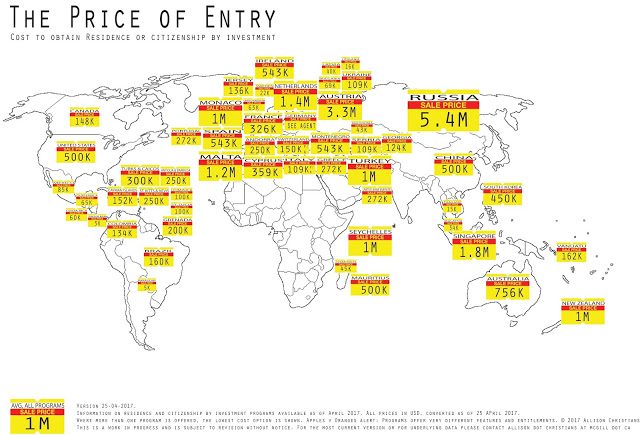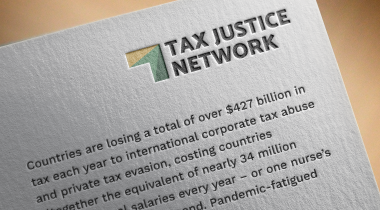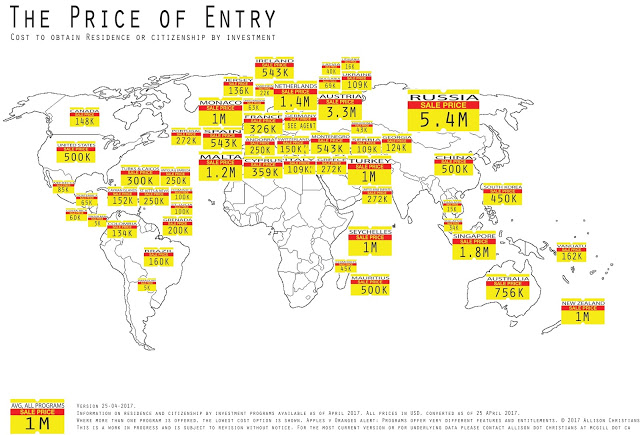
Naomi Fowler ■ The Price of Entry: residence and citizenship by investment around the world

Many thousands of people a year risk their lives to cross borders into what they hope will be countries of greater safety, opportunity and quality of life. Yet for others who are wealthy enough, the borders are open. For those who can pay, nationality, residency and freedom of movement are theirs.
There are many concerns around the issues of residency (see our recent blog Faking residency on how the OECD’s Common Reporting Standard for automatic exchange of banking information leaves the door wide open for fraud).
Associate Professor Allison Christians, H. Heward Stikeman Chair in the Law of Taxation at the McGill University is currently doing some very interesting research on so-called ‘residence and citizenship by investment’, a handy kind of ‘fundraiser’ that many countries seem keen on implementing. Why does this matter? Well, there are many, many concerns about this, and as blogger Christian Wayne says of this research,
“The implications of the commodification of citizenship and access to immigration vis-à-vis pay-to-play visa programs has long been a hot-button issue for international tax scholars and political scientists alike. Most historical analysis, however, does not typically consider the role taxation dynamics between origin and host countries can play, nor how they impact the tax regime in terms of gross revenue or the distributional effect on the wider economy.”
And he goes on, Allison Christian’s interest in immigrant investment programmes
“is what she dubs “The Inequality Factor”—that is, how much can wealthier, more developed countries demand in terms of higher prices and more stringent requirements (such as actual residence in the host country) for entry, versus how much poorer, less developed countries can demand in price and commitments from their applicants. Christians cautions that her research is still ongoing, but “the answer seems to be that there appears definitely a ‘rich get richer’ quality to the distinctions among programs, but there are lots of details in the programs that require further thought.”
Those of you reading this who listen to our monthly podcast the Taxcast (also available here, here and on iTunes) will have heard us discuss the slippery world of ‘residence planning’ and specifically the ‘synthetic residency’ dodge offered by Dubai in our January 2017 episode (starting at around 6 minutes 57). And this shocking example really does highlight the issue of just how low these offerings can go and how far countries will compete in a race to the bottom. Regrettably, there are plenty more of these.
Now, here’s what Allison Christians has presented on her team’s findings so far on her blog, along with a very interesting graphic:
I’ve been working on residence and citizenship by investment programs, and thanks to some stellar research assistance by Jake Heyka, have developed a set of data comprising what I believe is a fairly thorough look at the residence and citizenship by investment programs currently on offer around the world. I made the above infographic to show the lowest cost program per country for all countries that offer either residence or citizenship by investment.
The lowest cost residence by investment programs are offered by Panama and Paraguay, each coming in at about USD$5,000, while the most expensive is Russia, at over USD$5 million. The average price for all residence and citizenship by investment programs that we found is about $1 million, but this number isn’t perfect because some programs are based on job creation rather than investment (e.g., Portugal, Turkey, UK), some involve having entrepreneur/angel investment support rather than a direct investment (e.g. Australia, Canada), and some involve annual amounts (Italy and Switzerland).
One of the things I wondered about in looking over the programs is the inequality factor at play–that is, how much can richer/larger countries demand in terms of higher prices and more stringent requirements (such as actual residence) for entry, and how much must poorer/smaller countries be satisfied with smaller investments and fewer commitments by the applicant? The answer seems to be that there appears definitely a “rich get richer” quality to the distinctions among programs, but there are lots of details in the programs that require further thought.
The paper itself is still in progress but here is an explanation of what I am looking at:
International law and political theory scholars have long wrestled with the normative implications of commodifying citizenship and access to immigration with pay-to-play visa programs, but the analysis does not typically consider the role the tax system plays or could play in these schemes, nor how such schemes might impact the tax regime in terms of gross revenue or distributional effect. Yet governments increasingly view their tax systems as a means of potentially increasing the value of residence and citizenship in their countries, whether intrinsically or in relation to the treatment of those who gain such status by other means. Given the cost involved in reducing revenue from those arguably most able to pay, whether the programs actually produce the predicted outcomes is one obvious question to be asked. Even if the programs in fact achieve their goals, a second question surely arises regarding the normative justification for using the tax system to lure the wealthy away from other countries in this manner. Does the normative case differ when applied to humans as opposed to companies? Does it differ when the luring state is richer or poorer relative to the countries of origin of prospective immigrants? To sketch out a framework for analyzing these questions requires a sense of the various competing programs on offer. This essay takes the first step by comparing national programs that use their taxing power in some manner in order to attract immigration, and highlights some of the factors that raise normative questions about the appropriate design and uses of a tax system.
Allison Christians welcomes comments, and you can engage in this ongoing research here.
Related articles
One-page policy briefs: ABC policy reforms and human rights in the UN tax convention

Bad Medicine: A Clear Prescription = tax transparency
Tax justice pays dividends – fair corporate taxation grows jobs, shrinks inequality

Reclaiming tax sovereignty to transform global climate finance
Reclaiming tax sovereignty to transform global climate finance
16 June 2025

The “millionaire exodus” visualised
The millionaire exodus myth
10 June 2025

The Financial Secrecy Index, a cherished tool for policy research across the globe

When AI runs a company, who is the beneficial owner?
Insights from the United Kingdom’s People with Significant Control register
13 May 2025


